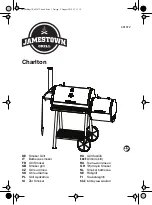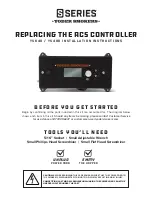
ABOUT SMOKE ALARMS
Battery (DC) operated Smoke Alarms: Provide protection even when
electricity fails, provided the batteries are fresh and correctly installed.
Units are easy to install, and do not require professional installation.
However, they do not provide interconnected functionality.
AC powered Smoke Alarms: Can be interconnected so if one unit
senses smoke, all units alarm. They do not operate if electricity fails.
AC Smoke Alarms must be installed by a qualified electrician.
AC/DC powered Smoke Alarms: (AC with battery back-up): Can be
interconnected so if one unit senses smoke, all units alarm. They will
operate if electricity fails, provided the batteries are fresh and correctly
installed. AC/DC Smoke Alarms must be installed by a qualified electrician.
Wireless Interconnected Alarms: Offer the same interconnected
functionality as with hardwired alarms, without wires. Units are easy
to install and do not require professional installation. They provide
protection even when electricity fails, provided the batteries are fresh
and correctly installed.
Smoke Alarms for Solar or Wind Energy users and battery backup
power systems:
AC powered Smoke Alarms should only be operated
with true or pure sine wave inverters. Operating this Smoke Alarm with
most battery-powered UPS (uninterruptible power supply) products or
square wave or “quasi sine wave” inverters will damage the Alarm.
If you are not sure about your inverter or UPS type, please consult with
the manufacturer to verify.
Smoke Alarms for the hearing impaired: Special purpose Smoke
Alarms should be installed for the hearing impaired. They include a visu-
al alarm and an audible alarm horn, and meet the requirements of the
Americans With Disabilities Act. These units can be interconnected so if
one unit senses smoke, all units alarm. They do not operate if electricity
fails. Units must be installed by a qualified electrician. This Smoke
Alarm is an AC powered unit that has an 85 decibel alarm and a
177 candela strobe light, which flashes rapidly when the unit is in
alarm. This unit is specially designed to wake hearing impaired
persons. It features an 85 dB alarm plus a brilliant 177 candela
strobe light that flashes rapidly when the unit senses smoke.
Smoke alarms are not to be used with detector guards unless the
combination has been evaluated and found suitable for that purpose.
All these Smoke Alarms are designed to provide early warning of fires if
located, installed and cared for as described in the user’s manual, and if
smoke reaches them. If you are unsure which type of unit to install, refer
to NFPA (National Fire Protection Association) 72 (National Fire Alarm
Code) and NFPA 101 (Life Safety Code). National Fire Protection
Association, One Batterymarch Park, Quincy, MA 02269-9101. Also check
your local building codes which may also require specific units in new
construction or in different areas of the home.
SPECIAL COMPLIANCE CONSIDERATIONS
This Smoke Alarm alone is not a suitable substitute for complete fire
detection systems in places housing many people—like apartment
buildings, condominiums, hotels, motels, dormitories, hospitals,
long-term health care facilities, nursing homes, day care facilities,
or group homes of any kind—even if they were once single-family
homes. It is not a suitable substitute for complete fire detection
systems in warehouses, industrial facilities, commercial buildings,
and special-purpose non-residential buildings which require special
fire detection and alarm systems. Depending on the building codes
in your area, this Smoke Alarm may be used to provide additional
protection in these facilities.
The following information applies to all four building types below:
In new construction, most building codes require the use of AC or
AC/DC powered Smoke Alarms only. In existing construction, AC,
AC/DC, or DC powered Smoke Alarms can be used as specified by
local building codes. Refer to NFPA 101 (Life Safety Code) or NFPA 72
(National Fire Alarm Code), local building codes, or consult your Fire
Department for detailed fire protection requirements in buildings not
defined as “households.”
1. Single-Family Residence: Single family home, townhouse. It is
recommended Smoke Alarms be installed on every level of the home,
in every bedroom, and in each bedroom hallway.
2. Multi-Family or Mixed Occupant Residence: Apartment building,
condominium. This Smoke Alarm is suitable for use in individual apart-
ments or condos, provided a primary fire detection system already
exists to meet fire detection requirements in common areas like lobbies,
hallways, or porches. Using this Smoke Alarm in common areas may not
provide sufficient warning to all residents or meet local fire protection
ordinances/regulations.
3. Institutions: Hospitals, day care facilities, long-term health care
facilities. This Smoke Alarm is suitable for use in individual patient sleep-
ing/resident rooms, provided a primary fire detection system already
exists to meet fire detection requirements in common areas like lobbies,
hallways, or porches. Using this Smoke Alarm in common areas may not
provide sufficient warning to all residents or meet local fire protection
ordinances/regulations.
4. Hotels and Motels: Also boarding houses and dormitories. This
Smoke Alarm is suitable for use inside individual sleeping/resident
rooms, provided a primary fire detection system already exists to meet
fire detection requirements in common areas like lobbies, hallways, or
porches. Using this Smoke Alarm in common areas may not provide
sufficient warning to all residents or meet local fire protection
ordinances/regulations.
LIMITATIONS OF SMOKE ALARMS
Smoke Alarms have played a key role in reducing deaths resulting from
home fires worldwide. However, like any warning device, Smoke Alarms
can only work if they are properly located, installed, and maintained,
and if smoke reaches them. They are not foolproof.
Smoke alarms may not waken all individuals. Practice the escape
plan at least twice a year, making sure that everyone is involved – from
kids to grandparents. Allow children to master fire escape planning and
practice before holding a fire drill at night when they are sleeping.
If children or others do not readily waken to the sound of the smoke
alarm, or if there are infants or family members with mobility limitations,
make sure that someone is assigned to assist them in fire drill and in
the event of an emergency. It is recommended that you hold a fire drill
while family members are sleeping in order to determine their response
to the sound of the smoke alarm while sleeping and to determine
whether they may need assistance in the event of an emergency.
Smoke Alarms cannot work without power. Battery operated units
cannot work if the batteries are missing, disconnected or dead, if the
wrong type of batteries are used, or if the batteries are not installed
correctly. AC units cannot work if the AC power is cut off for any
reason (open fuse or circuit breaker, failure along a power line or at a
power station, electrical fire that burns the electrical wires, etc.).
If you are concerned about the limitations of battery or AC power,
install both types of units.
Smoke Alarms cannot detect fires if the smoke does not reach
them. Smoke from fires in chimneys or walls, on roofs, or on the other
side of closed doors may not reach the sensing chamber and set
off the alarm. That is why one unit should be installed inside each
bedroom or sleeping area—especially if bedroom or sleeping area
doors are closed at night—and in the hallway between them.
Smoke Alarms may not detect fire on another floor or area of the
home.
For example, a stand-alone unit on the second floor may not
detect smoke from a basement fire until the fire spreads. This may
not give you enough time to escape safely. That is why recommended
minimum protection is at least one unit in every sleeping area, and every
bedroom on every level of your home. Even with a unit on every floor,
stand-alone units may not provide as much protection as interconnected
units, especially if the fire starts in a remote area. Some safety experts
recommend installing interconnected AC powered units with battery
back-up (see “About Smoke Alarms”) or professional fire detection
systems, so if one unit senses smoke, all units alarm. Interconnected
units may provide earlier warning than stand-alone units since all units
alarm when one detects smoke.
Smoke Alarms may not be heard. Though the alarm horn in this unit
meets or exceeds current standards, it may not be heard if: 1) the unit
is located outside a closed or partially closed door, 2) residents recently
consumed alcohol or drugs, 3) the alarm is drowned out by noise from
stereo, TV, traffic, air conditioner or other appliances, 4) residents are
hearing impaired or sound sleepers. Special purpose units, like those
with visual and audible alarms, should be installed for hearing impaired
residents.
Smoke Alarms may not have time to alarm before the fire itself
causes damage, injury, or death, since smoke from some fires may
not reach the unit immediately. Examples of this include persons
smoking in bed, children playing with matches, or fires caused by
violent explosions resulting from escaping gas.
Smoke Alarms are not foolproof.
Like any electronic device, Smoke
Alarms are made of components that can wear out or fail at any time.
You must test the unit weekly to ensure your continued protection.
Smoke Alarms cannot prevent or extinguish fires. They are not a
substitute for property or life insurance.
Smoke Alarms have a limited life. The unit should be replaced
immediately if it is not operating properly. You should always replace a
Smoke Alarm after 10 years from date of purchase. Write the purchase
date on the space provided on back of unit.
6
BRK
®
is a registered trademark of BRK Brands, Inc.
First Alert
®
is a registered trademark of the First Alert Trust.
Printed in Mexico M08-0142-002 K1
08/08
























